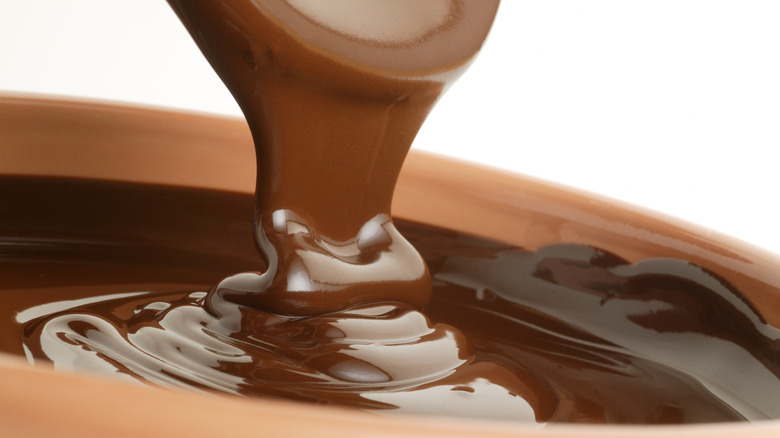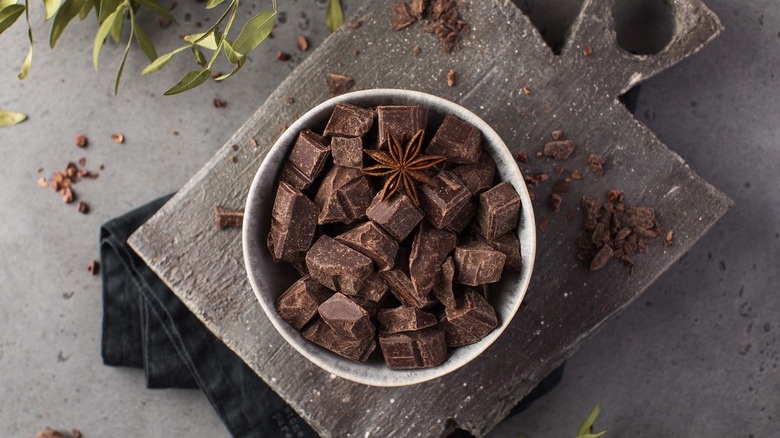How To Get Smoothly Melted Chocolate In The Air Fryer
Let's be honest — melting chocolate for a homemade confectionary or pastry is a complete chore. This internationally ubiquitous candy is a surprisingly fickle ingredient to work with when it comes to baking or molding, mostly due to its complex composition of sugars and fats. There's so much that can go wrong while trying to melt chocolate, from burning to seizing just because of a simple misstep. Microwaving makes the process much easier, but if the inside of your microwave oven gets even a little misty, your chocolate will most likely seize up and ruin itself. Not to mention, one of the biggest mistakes you can make while microwaving chocolate is using too high of a setting. If your microwave doesn't have the option to adjust its power output, you might have chronic troubles with what even professional cooks have called their favorite chocolate-melting method.
Thankfully, there's still a way to easily melt chocolate without having to go for the full double-boil setup. If you've got an air fryer, you already have the perfect appliance for a fuss-free chocolate melting process — provided you also have an air fryer-safe bowl, of course. While it may take a little longer than microwaving, air-frying your chocolate is a simple and easy way of guaranteeing smooth melted chocolate without needing the expertise or equipment of a full-on chocolatier.
How to melt chocolate in the air fryer
The first thing you should know before melting chocolate is that water is chocolate's worst enemy. Even the smallest presence of moisture can cause chocolate to seize during melting, as the sugars clump onto the water instead of the fats, and a figurative and almost literal wrench is thrown into the entire melting process. That's why the most professional and traditional method of melting chocolate involves using a double boiler — that is, a bowl set on top of a pot of boiling water so that you get all the mellow heat of steam without the moisture.
Air fryers, being a compact convection oven, provide an excellent environment for melting chocolate. The convection mechanisms drastically reduce any chance that stray moisture will develop or get trapped inside, circumventing concerns over seizing. Furthermore, you can always adjust the temperature on even the most budget models of air fryers, giving you much more precise control over the entire process.
What you'll want to do is set your air fryer to preheat to 250 degrees Fahrenheit. For the best results, chop or grate the chocolate beforehand to smooth out and shorten the process. Once the air fryer is done preheating, put your chocolate in a heat-safe bowl and carefully set it into the air fryer basket. While you can theoretically leave the chocolate in there for 3 to 5 minutes until done, you may want to check in on it every so often to stir and make sure it doesn't burn around the edges.
Things to consider when melting chocolate in the air fryer
While melting chocolate in the air fryer is easy and convenient, there are a few things to keep in mind to make sure things don't go sideways in the process. As mentioned, any presence of water is the death knell of melted chocolate, so it's important to fully dry out any and all utensils and bowls you'll be using before they come into contact with the chocolate. This includes the inside of the air fryer. If you've cooked something particularly moist in there just before your chocolate, you'll probably want to double-check and give the basket as well as the chamber a quick wipe-down.
Another important thing to consider is the material of the bowl you'll be using. Most, if not all oven-safe bowls are also air-fryer safe, but an important thing to note is that different materials heat up to different degrees. Metal can absorb blistering amounts of heat in a very short time, and a metal bowl increases the chances that your chocolate might start burning around the edges while in the air fryer. To give your chocolate the best chance possible, stick to glass, ceramic, stone, or food-grade silicone containers, all of which heat up much slower than metal and are less likely to burn your chocolate in the 3 to 5 minutes of melting.


